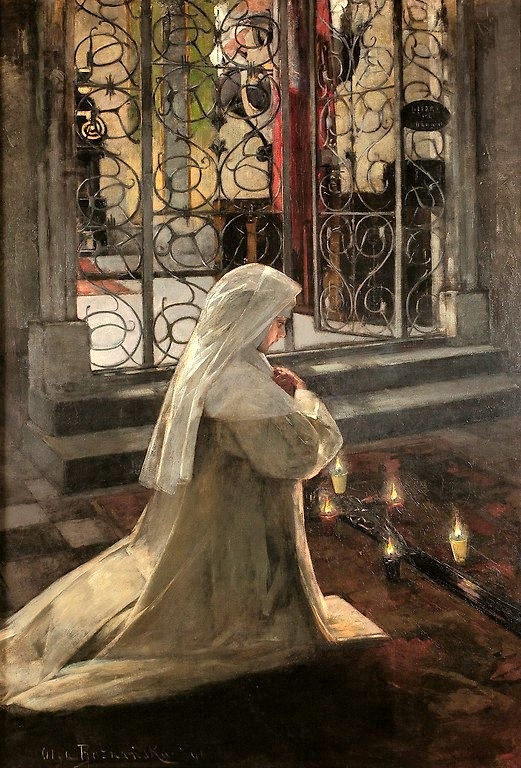Wounds of Love follows the journey of Saint Pio from his youth as a farm boy to his days as the beloved wonderworker of San Giovanni Rotonda. Read on to experience the moment that Padre Pio received the stigmata.
One day in 1910, Pio was sitting beneath the elm tree, praying intensely, so focused that he was barely aware of his surroundings. The eyes of his mind dwelt on the Passion of Christ.
The friar winced as he pictured the scourging of Christ. His brow began to drip with beads of sweat as he pondered the crown of thorns twisted upon the head of the suffering Lord. He heaved and sighed and cried out, “My Jesus!” as he imagined the nails being driven into the hands of Christ.
Pio felt overwhelmed by the love with which Christ suffered on behalf of men. It seemed so vivid, so real.
In the midst of his reverie, he suddenly began to feel a burning sensation spreading across his palms. He opened his eyes and rubbed them. When the sensation grew stronger, he began to grimace.
“Ah!” Then holding his hands up, he noticed a red spot, no bigger than a small coin, imprinted on the center of his palms. They were barely visible but tender to the touch and extremely painful.
Pio leapt up and began to run toward his family’s home but stumbled and fell. His feet too began to suffer from a sharp pain. He struggled to pull himself up and hobble toward his home, wincing like an injured soldier with every step.
An hour later, Pio came tumbling through the doorway of the Forgione home. His mother and sisters were working in the kitchen. Mamma Peppa glanced over her shoulder briefly but quickly returned to her cooking. “My son, I did not expect to see you here today. Will you be staying for dinner?” When he did not respond, she turned around completely. Pio knelt on the floor, waving his hands in the air and rubbing them as if trying to cool them down from a burn.
“What is this nonsense?” she asked. “Are you a guitar player now?”
“Please, Mama, bring me a bowl of water!”
Mamma Peppa fetched her son a basin of water, though not as quickly as he would’ve liked. Pio sat down at the table and dunked his hands into the bowl. The water did little to relieve his pain.
“What’s wrong with your hands? Let me see!”
“No, Mama, it’s fine . . .”
“Let me see your hands,” she repeated, jerking them out of the bowl. He grimaced as she examined his palms. Her eyes drifted back up to meet his. She shrugged. “I don’t see anything.”
Pio nodded, doing his best to hold back tears. “Yes, it’s probably nothing, Mama. Don’t worry about me.”
The strange pain in Pio’s hands marked the beginning of a long period of suffering for the friar. His hands and feet were in constant pain, despite there being no visible wounds. Sometimes the light red spots would reappear on his hands and feet, but they were barely noticeable. Pio was embarrassed and perplexed by the mysterious condition. He did not want to talk about it, fearing that others would say he had lost his mind.
Pio did feel obliged, however, to explain the entire affair to his spiritual director, Padre Agostino.
“My dear son,” Padre Agostino replied, “the Lord has given you these wounds of love to help you identify with him in his suffering and to become a holy victim for the salvation of souls. Embrace whatever God gives you. As with all things, this is a grace.”
Though Pio suffered greatly, his director was indeed correct—Pio discerned many graces that he received from his wounds. He noticed first and foremost that his prayer life adopted a greater intensity. Pio had always been spiritually sensitive, but now the spiritual world seemed to come alive even more. He became intuitively aware of peoples’ spiritual struggles before they even told him, and he saw with greater clarity the battle being waged for their souls. Sometimes, he could even see his guardian angel or other mystical visions.
His Masses, too, began to change. It became difficult for Pio to pray the Canon of the Mass without getting overwhelmed at the majesty of what was occurring on the altar and in his very hands. Prayers like the Memento Domine and Hanc igitur, prayers that took most priests only a moment to say, took Pio many minutes to get through. Sometimes, after pronouncing the solemn words “Hoc est enim Corpus meum (This is My body)” and elevating the host, he would hold the Body of Christ aloft in silence for several minutes, gazing at the Host in adoration, tears welling in his eyes. Some parishioners began to complain.
“Why does he take so long? I have places to be!”
“I do not understand how a man could speak so slowly!”
“I think the tears he sheds are all an act.”
Still, others were amazed and flocked to his Masses as if his being enraptured by the Blessed Sacrament was contagious and would spread to them. To watch Padre Pio offer Mass was to watch a man in love, and how could such love be restrained?
ooo
This article is taken from a chapter in Wounds of Love by Phillip Campbell which is available from TAN Books.









